
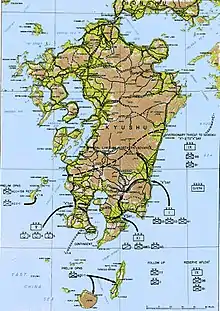
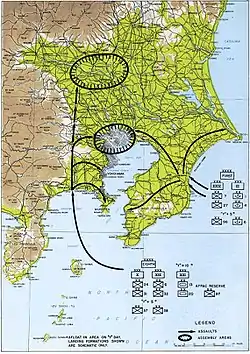
Operation Downfall was the proposed Allied plan for the invasion of the Japanese home islands near the end of World War II.
The operation had two parts, Operation Olympic, intended to capture the southern third of the southernmost main Japanese island, Kyūshū, and Operation Coronet, the planned invasion of the Kantō Plain, near Tokyo, on the main Japanese island of Honshu. Olympic was scheduled for November 1945, to be followed by Coronet in early 1946.
If Downfall had taken place, it would have been the largest amphibious operation in history, surpassing D-Day.[1] The planned operation was canceled when Japan surrendered following the atomic bombings of Hiroshima and Nagasaki, the Soviet declaration of war, and the invasion of Manchuria.[2]
Order of Battle for Olympic
Allied
for the invasion of Japan

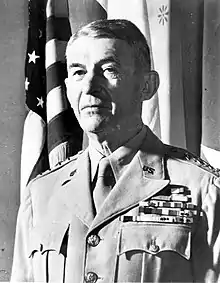
Supreme Commander, Allied Forces Pacific
General Douglas MacArthur
Ground forces
Should these four corps prove insufficient to accomplish the tasks assigned, elements earmarked for Coronet would be used to reinforce Sixth Army at the rate of three divisions per month beginning about 30 days after the initial landings.
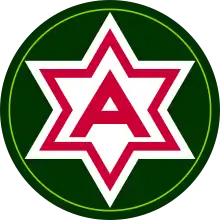 Sixth Army
Sixth Army- General Walter Krueger[3]
- Peripheral landings
 40th Infantry "Sunburst" Division (Landing on Yakushima and Koshikijima Islands)
40th Infantry "Sunburst" Division (Landing on Yakushima and Koshikijima Islands)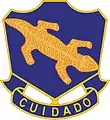 158th Infantry Regiment (Landing on Tanegashima)
158th Infantry Regiment (Landing on Tanegashima)
 I Corps (Landing at Miyazaki)[3]
I Corps (Landing at Miyazaki)[3]- Major General Innis P. Swift
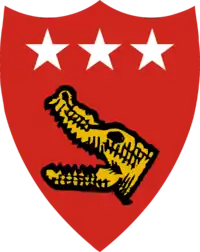 V Amphibious Corps (Landing at Kushikino)[3]
V Amphibious Corps (Landing at Kushikino)[3]- Major General Harry Schmidt, USMC
 XI Corps (Landing at Ariake)[3]
XI Corps (Landing at Ariake)[3]- Major General Charles P. Hall
 IX Corps (Reserve afloat)[3]
IX Corps (Reserve afloat)[3]- Major General Charles W. Ryder
- Follow-up units:
- Peripheral landings
Naval forces
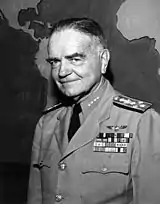
.jpg.webp)
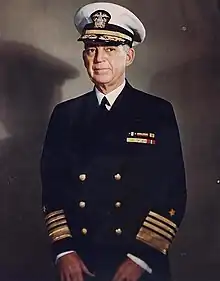
- Third Fleet
- Admiral William F. Halsey
- 20 fleet and light aircraft carriers
- 9 battleships
- 26 cruisers
- 75 destroyers
- incl. British Pacific Fleet
- 6 fleet and light carriers
- Fifth Fleet
- Admiral Raymond A. Spruance
- 36 escort carriers
- 11 battleships
- 26 cruisers
- 387 destroyers and destroyer escorts
- 394 AKA, AP, APA, APD, APH
- 977 LSD, LSM, LST, and LSV
- Seventh Fleet
- Admiral Thomas C. Kinkaid
Air forces

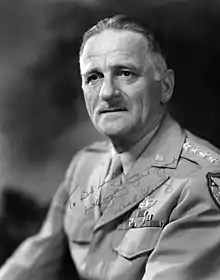
- Far East Air Forces
- General George C. Kenney (119,000 men) – 14 bomber groups, 10 fighter groups
- United States Strategic Air Forces in the Pacific
- General Carl A. Spaatz
- Major General Curtis E. LeMay[lower-alpha 1]
- Twentieth Air Force (Lt. Gen. Nathan Twining) (77,000 men)
- 1,000 B-29 Superfortresses
- Eighth Air Force (Lt. Gen. Jimmy Doolittle)
- Twentieth Air Force (Lt. Gen. Nathan Twining) (77,000 men)
- Commonwealth forces
- Tiger Force (detached from RAF Bomber Command):
- 480–580 Avro Lancaster bombers (about half to be used as tankers for in-flight refuelling)
- Australian First Tactical Air Force
- 20 fighter/attack squadrons from the Royal Australian Air Force
- Tiger Force (detached from RAF Bomber Command):
Japan
Ground forces

- Second General Army
- Field Marshal Shunroku Hata[lower-alpha 2]
- Sixteenth Area Army
- Lieut. General Yokoyama Isamu (600,000 men)
- Northern Kyūshū — 56th Army
- Lieut. General Ichiro Shichida (365,000)[4]
- 145th Division
- 312th Division
- 351st Division
- 124th Independent Mixed Brigade
- 57th Division (20,000 men)
- 4th Tank Brigade
- Southeastern Kyūshū — 57th Army
- Lieut. General Nishihara Kanji (150,000 men)
- Tanegashima—109th Independent Mixed Brigade (5,900 men)
- Miyazaki—154th Division, 156th Division, 212th Division[4] (55,000 men)
- Ariake—86th Division, 98th Independent Mixed Brigade, 1 regiment, 3 infantry battalions (29,000 men)
- 25th Division, 5th Tank Brigade, 6th Tank Brigade[4]
- Southwestern Kyūshū — 40th Army
- Lieut. General Nakazawa Mitsuo (85,000 men)
- 303rd Division (12,000 men) (Sendai)
- 206th Division (Fukiage)
- 146th Division, 125th Independent Mixed Brigade (S. Satsuma Peninsula)
- 77th Division[4] 1 tank regiment
- 216th Division[4] 4 brigades
Air forces
- Air General Army
- General Masakazu Kawabe
Order of Battle for Coronet
Allied
Ground forces
for Operation Coronet
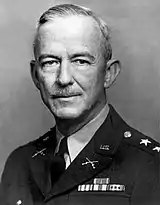
.jpg.webp)
 First Army
First Army- General Courtney H. Hodges[3][lower-alpha 3]
 Eighth Army
Eighth Army- Lieut. General Robert L. Eichelberger
- United States Army Forces Pacific reserve[3]
Thirty days after the initial assault, each army would be reinforced by a corps of 3 divisions. Five days later an airborne division and a United States Army Forces Pacific Reserve Corps of 3 divisions would be made available. Strategic reserve for the entire operation would consist of a corps of 3 divisions located in the Philippines and divisions from the United States to permit reinforcement at the rate of 4 per month.[3]
Unsourced listing of the aforementioned reinforcements
- For First Army
- Unnamed follow-on corps
- For Eighth Army
- Unnamed follow-on corps
- United States Army Forces Pacific reserve
 11th Airborne Division
11th Airborne Division- Unnamed follow-on corps
- Strategic reserve
- British Commonwealth Ground Forces
Japan
for the defense of Honshu
.jpg.webp)

All Japanese formations on Honshu were badly understrength and lacking in equipment. The American First Army's landings would likely have been opposed by the Japanese 52nd Army and the Eighth Army's landings by the Japanese 53rd Army.
- First General Army
- Field Marshal Hajime Sugiyama[lower-alpha 4]
- Twelfth Area Army
- General Shizuichi Tanaka[lower-alpha 5]
- 36th Army – Urawa, Saitama
- 51st Army – Tsuchiura, Ibaraki
- 44th Division – Ogawa
- 151st Division – Mito
- 221st Division – Kashima
- 115th Independent Mixed Brigade – Shibasaki
- 116th Independent Mixed Brigade – Hokota
- 7th Independent Armored Brigade – Ogawa
- 52nd Army – Sakura, Chiba
- 3rd Imperial Guards Division – Naruto
- 147th Division – Mobara
- 152nd Division – Choshi
- 234th Division – Sōsa
- 3rd Independent Armored Brigade
- 8th Artillery Headquarters
- 53rd Army – Isehara, Kanagawa
- 84th Division – Odarawa
- 140th Division – Kamakura
- 316th Division – Isehara
- 117th Independent Mixed Brigade – Numazu
- 2nd Independent Armored Brigade – Tsudanuma
- 11th Artillery Headquarters – Hiratsuka
- Tokyo Bay Garrison – Choshi, Chiba
- 321st Division – Tokyoa
Notes
- ↑ Running mate of segregationist presidential candidate George C. Wallace in 1968.
- ↑ Sentenced to life imprisonment for war crimes in 1948 but paroled in 1955
- ↑ Commanded First Army during Battle of the Bulge
- ↑ Committed suicide by gunshot following Japan's surrender
- ↑ Committed suicide by gunshot following Japan's surrender
References
- ↑ "XIII 'Downfall'". The Plan For The Invasion of Japan. United States Army Center of Military History. Retrieved January 23, 2016.
- ↑ Giangreco, Dennis M. (2009). Hell to Pay: Operation Downfall and the Invasion of Japan, 1945–1947. Annapolis, MD: Naval Institute Press. p. xvi. ISBN 978-1-59114-316-1.
- 1 2 3 4 5 6 7 8 9 10 11 12 13 "Chapter XIII "Downfall" The plan for the invasion of Japan". US Army Center of Military History. Retrieved 7 June 2020.
- 1 2 3 4 5 The majority of these units (86,000 men total) would have been ordered to counterattack at Ariake, though it is questionable how many of the tanks would have been able to survive an air attack.